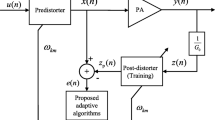Abstract
Adaptive digital predistortion is one of the most promising linearization technique, which leads to more efficient and cost-effective high power amplifier (HPA). In this paper, a fast-converging variable step-size least mean square algorithm based on hybrid indirect learning structure is presented to provide an unbiased predistortion identification in the non-stationary signal condition for wideband HPA. By using a variable step-size strategy, the proposed identifying algorithm can adapt its learning rate according to the dynamic range of input signal. Thus, more stable learning convergence and lower steady-state mis-adjustment error are obtained simultaneously. A comprehensive theoretical analysis is presented, and some important results including learning stability, convergence behavior, and selection criteria for initialization parameter setting are derived. Both its superiority and robustness are well confirmed through extensive numerical simulations.






Similar content being viewed by others
References
Liu, Y. J., Chen, W., Zhou, J., Zhou, B., & Ghannouchi, F. (2013). Digital predistortion for concurrent dual-band transmitters using 2-D modified memory polynomials. IEEE Transactions on Microwave Theory and Techniques, 61(1), 281–290.
Haykin, S. O. (2013). Adaptive filter theory (5th ed.). Upper Saddle River: Prentice Hall Press.
Mandic, D. P. (2004). A generalized normalized gradient descent algorithm. IEEE Signal Processing Letters, 11(2), 115–118.
Rawat, M., Ghannouchi, F. M., & Rawat, K. (2013). Three-layered biased memory polynomial for dynamic modeling and predistortion of transmitters with memory. IEEE Transactions Circuits and Systems I: Regular Papers, 60(3), 768–777.
Morgan, D. R., Ma, Z., & Ding, L. (2003). Reducing measurement noise effects in digital predistortion of RF power amplifiers. In IEEE ICC (pp. 2436–2439).
Ding, L., Zhou, G. T., Morgan, D. R., Ma, Z., Kenney, J. S., Kim, J., et al. (2004). A robust digital baseband predistorter constructed using memory polynomials. IEEE Transactions on Communications, 52(1), 159–165.
Lee, J., Jeon, S., Kim, J., & Suh, Y. (2013). Adaptive HPA linearization technique for practical ATSC DTV system. IEEE Transactions on Broadcasting, 59(2), 376–381.
Ding, L., Ma, Z., Morgan, D. R., Zierdt, M., & Pastalan, J. (2006). A least-squares/Newton method for digital predistortion of wideband signals. IEEE Transactions on Communications, 54(5), 833–840.
Zhou, D., & DeBrunner, V. E. (2007). Novel adaptive nonlinear predistorters based on the direct learning algorithm. IEEE Transactions on Signal Processing, 55(1), 120–133.
Liu, Y. J., Zhou, J., Chen, W., & Zhou, B. (2014). A robust augmented complexity -reduced generalized memory polynomial for wideband RF power amplifiers. IEEE Transactions on Industrial Electronics, 61(5), 2389–2401.
Kim, J., & Konstantinou, K. (2001). Digital predistortion of wideband signals based on power amplifier model with memory. Electronics Letters, 37, 1417–1418.
Liu, Y. J., Chen, W., Zhou, J., Zhou, B. H., Ghannouchi, F. M., & Liu, Y. N. (2012). Modified least squares extraction for Volterra-series digital predistorter in the presence of feedback measurement errors. IEEE Transactions on Microwave Theory and Techniques, 60(11), 3559–3570.
Slock, D. T. M., & Kailath, T. (1988). Numerically stable fast recursive least squares transversal filters. In ICASSP, (pp. 1365–1368).
Acknowledgements
The authors would like to thank the anonymous reviewers, and also thank the support by the National Natural Science Foundation of China (No. 61101145), and 111 Project (No. B08038).
Author information
Authors and Affiliations
Corresponding author
Rights and permissions
About this article
Cite this article
Wang, Y., Zhang, F. Adaptive Digital Predistortion Based on Hybrid Indirect Learning Structure with Variable Step-Size for Wideband HPA. Wireless Pers Commun 96, 3015–3026 (2017). https://doi.org/10.1007/s11277-017-4338-5
Published:
Issue Date:
DOI: https://doi.org/10.1007/s11277-017-4338-5




